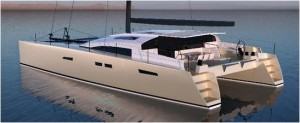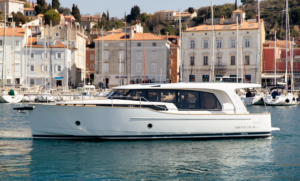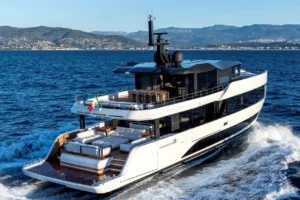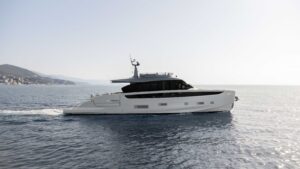Le Breton Yachts

Le Breton Yachts introduced the SIG60 model at the Cannes boat show in September 2012. The SIG60 is a high-performance, short-handed, blue water cruising yacht. This bigger sister of the award-winning SIG45 was designed to cater to sailors who are looking for true live-aboard accommodation, but are not willing to compromise on elegance or sparkling performance under sail. Coming of Age Multihulls have been the black sheep of the yachting world ever since Nathaniel Herreschoff’s radical catamaran “Amaryllis” was banned from racing in 1875, ostensibly for being “neither a yacht nor a boat”. But it was clear that the real reason for the ban was that she was simply too fast for the opposition. How times have changed! Today, multihulls hold almost all of the world’s official sailing records, and not by a small margin. The transatlantic record (held by the 131ft trimaran Banque Populaire V) is three days and 15 hours. The monohull record (held by the 140ft MariCha IV) is six days and 17 hours. And now, 138 years on from Herreschoff’s visionary yacht, the most prestigious sailing race of all, the America’s Cup, is being sailed in multihulls. Multihulls have also revolutionised recreational sailing, offering previously unheard of space and comfort on a platform which does not heel. As a result, the multihull market is one of the few segments of the yachting market still growing, approaching a market share of 20-30% from almost nothing just 25 years ago. It would not be unreasonable to say that multihulls have finally come of age in the 21st century. The kitchen sink and more…. However, while racing multihull performance continues to mesmerise us, cruising catamarans tend to amaze with the amount of systems and volume that can be squeezed into a given length. Regrettably, this has a predictable effect on sailing performance. And while outright speed is certainly not the primary design criterion for a cruising yacht, a fast yacht offers many very real benefits, including quick passage; extended range; smooth motion through a seaway; the ability to outrun and avoid bad weather; and, last but certainly not least, a pleasurable helming experience. Philosophical considerations Designing a yacht involves literally hundreds of choices and trade-offs. The only way to ensure a coherent outcome is to first define a clear philosophy. The philosophy of the SIG60 – an elegant, high performance world cruiser for couples and families – defines the result of the design process. “Elegant” requires long, flowing lines, and a low profile. “Performance” requires light weight, low windage, slender hulls, and a powerful rig. “Cruiser” implies storage, comfortable living areas, amenities and more storage. “Couples/Family” mean easy handling, simple systems. “World” underscores the requirement for simplicity and limited maintenance requirements. While some of these requirements are in conflict, Le Breton Yachts found that a surprising number complemented each other: simple systems, limited maintenance, light weight. Easy handling and low profile (less windage). Others provide more of a challenge. The power of the rig requires an extremely well conceived deck layout and handling systems. Slender hulls and storage are not always happy bedfellows. To balance conflicting requirements, compromises must be made. But the beauty of a clearly-defined philosophy is that these compromises support and strengthen the primary objectives of the yacht. The result is a unique yacht. The SIG60 offers a beautiful home away from home, which can, if required for pleasure or expediency, sail at speeds well in excess of 20 knots. The yacht has many of the standard features of a modern catamaran, but also has several differentiating benefits. Accommodation The SIG60’s interior has a number of special features, but the saloon / galley arrangement was designed to be particularly inviting. As the heart of the yacht, a significant proportion of the total volume is dedicated to it. With the engines placed amidships to keep weight centred, the soles in the central area of the hulls are raised. Combined with a particularly wide coach roof, this mezzanine area greatly increases the sense of space in the saloon. The galley has been placed to port on this mezzanine level. While the cook still remains involved in the social activities of the saloon, the galley relocation frees up an enormous amount of room in the main part of the saloon. In particular, it uniquely allows the main seating and dining area to face forward – much more pleasant under sail. It also provides space for a luxurious day bed next to the forward-facing chart table, for watches or unexpected guests. The standard layout offers four cabins and three heads. The generous aft cabins have en suite facilities, while the forward cabins share a head compartment. An option, well suited to those wishing to employ crew, offers bunk beds in the port forward cabin and a small heads forward. Access would be either via the galley or the deck hatch. (See high resolution pictures) Cockpits and Deck Layout If the saloon is the heart of the yacht, the cockpit is its brain. A boat which is designed to be sailed by self-sufficient couples and families must by definition be intelligent, practical and intuitive. The innovative cockpits of the SIG60 are a key feature of the deck layout, offering numerous benefits. All sail controls are led back to the cockpit winches by the helms, obviating the need for the crew to go to the mast to reef. Keeping the winches outboard rather than central means that the rig is not obscured by the bimini when hoisting or reefing sails. While it seems to us a vital consideration, many catamarans do not offer the helmsman both a good view of the sails, and a good view forward and athwartships. The raised outboard aft helm positions of the SIG60 do exactly this, and offer several other advantages. The coaming protects the helmsman and crew from wind and weather. A boat capable of high speeds generates lots of apparent wind. Even in warm climates, 25 knots of apparent wind can quickly become chilly, and even tiring. By keeping the wheels close to the rudders they keep cable runs shorter, which results in light, responsive steering. Finally, the outboard working cockpits not only provide a separation from the al fresco dining area, but create a focal point around the helmsman when sailing. The conventional multihull practice of placing the wheel against the saloon bulkhead isolates the helmsman from the rest of the crew. In contrast, the steering position of the SIG60 places the wheels at the centre of the social cockpit areas, just like a monohull. The other main deck area is forward of the saloon. The mast base platform provides an important utility (generator, anchor windlass and chain) and stowage area, keeping heavy items well centred. Extending forward beyond the coachroofs, it is easy to access from the side decks and makes a wonderful sunbathing spot! The SIG60 does not have a flybridge as has become popular on some cruising cats. While lots of fun on a party boat, such features add little value to a family sailing their yacht upwind on a long passage and detract substantially from performance and stability. (See high resolution pictures) Performance The SIG60’s motto is “Expanding horizons with greater performance”. Speed is simply a huge luxury. Cruising yachts are certainly not sailed fast all the time. Indeed, yachts spend more time moored than sailing. But if all we wanted was a sea view, a beach front property would probably be a better investment! A yacht should, therefore, sail well. An easily driven yacht enables good speeds even under reduced sail, smaller sheet loads, longer range and the option of speed when needed (to escape poor weather) or when wanted (for pure enjoyment!). A lightweight modern catamaran like the SIG60 offers a small crew easy speed. 300+nm days are well within reach, meaning an Atlantic crossing from the Canary Islands to the Caribbean in less than 10 days. Importantly, the long slender hulls and centred weights reduce both pitching and deceleration in waves. The result is an astonishingly smooth ride more like that of a much larger yacht. The SIG60’s speed is derived from stiffness, lightweight and racing pedigree. With a raceboat quality carbon fibre structure and rig, the SIG60 will be one of the strongest, lightest and fastest cruising yachts on the market. Hugo Le Breton, founder of Le Breton Yachts, has developed the SIG60 in collaboration with top multihull design firm Van Peteghem Lauriot Prevost (VPLP). VPLP’s uniquely rich experience of cruising and racing multihulls, in combination with Le Breton Yachts’ construction quality guarantees that the SIG60 will be a delight to sail. Conclusion The SIG60 seeks to offer that elusive combination of a fast yacht with true blue water cruising ability. It achieves it by combining high tech composite construction techniques (light weight), state-of-the-art design (ergonomics and performance), and innovative interior design. The compromise is that the SIG60 is not the market leader in terms of interior volume, or jet ski carrying capacity. But it is one of the only yachts on the market which will allow you and your family to travel the world in luxury, and enjoy truly outstanding sailing performance while doing so. Click here to download high resolution pictures of the SIG60. Background Le Breton Yachts The company was founded by Hugo Le Breton to combine the incredible advances in ocean-racing multihulls with modern design, to create very fast, very beautiful, but above all, fun, safe and usable yachts. Le Breton Yachts offers three models – the SIG45 (two launched), SIG60 and SIG80. SIG is an acronym for Speed, Innovation and Grace. Design Team Le Breton Yachts has developed the SIG60 in collaboration with top multihull design firm Van Peteghem Lauriot Prevost (VPLP) and Adam Voorhees Design. VPLP has designed most of the world’s fastest sailing yachts, including Banque Populaire (round-the-world record, 24hr record), Hydroptère (51.2 knots over 1nm) and BMW Oracle’s America’s Cup winning trimaran. As designers of the Lagoon range of cruising catamarans, their practical cruising and production building knowledge is encyclopaedic. Talented designer Adam Voorhees, who was voted World Superyacht Young Designer of the year in 2010, worked with le Breton Yachts on styling and interior design.


